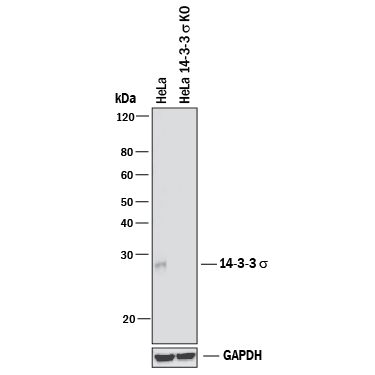Human/Mouse/Rat 14-3-3 sigma Antibody Summary
Met1-Ser248
Accession # P31947
Applications
Please Note: Optimal dilutions should be determined by each laboratory for each application. General Protocols are available in the Technical Information section on our website.
Scientific Data
 View Larger
View Larger
Detection of Human/Mouse/ Rat 14‑3‑3 sigma by Western Blot. Western blot shows lysates of A431 human epithelial carcinoma cell line and mouse brain tissue. PVDF membrane was probed with 1 µg/mL Goat Anti-Human/ Mouse/Rat 14-3-3s Antigen Affinity-purified Polyclonal Antibody (Catalog # AF4424) followed by HRP-conjugated Anti-Goat IgG Secondary Antibody (Catalog # HAF017). For additional reference, recombinant human 14-3-3 beta, epsilon, eta, gamma, sigma, theta, and zeta (2 ng/lane) were included. A specific band for 14-3-3 sigma was detected at approximately 28 kDa (as indicated). This experiment was conducted under reducing conditions and using Immunoblot Buffer Group 1.
 View Larger
View Larger
Western Blot Shows Human 14‑3‑3 sigma Specificity by Using Knockout Cell Line. Western blot shows lysates of HeLa human cervical epithelial carcinoma parental cell line and 14-3-3s knockout HeLa cell line (KO). PVDF membrane was probed with 1 µg/mL of Goat Anti-Human/Mouse/Rat 14-3-3s Antigen Affinity-purified Polyclonal Antibody (Catalog # AF4424) followed by HRP-conjugated Anti-Goat IgG Secondary Antibody (Catalog # HAF017). A specific band was detected for 14-3-3s at approximately 28 kDa (as indicated) in the parental HeLa cell line, but is not detectable in knockout HeLa cell line. GAPDH (Catalog # AF5718) is shown as a loading control. This experiment was conducted under reducing conditions and using Immunoblot Buffer Group 1.
Reconstitution Calculator
Preparation and Storage
- 12 months from date of receipt, -20 to -70 °C as supplied.
- 1 month, 2 to 8 °C under sterile conditions after reconstitution.
- 6 months, -20 to -70 °C under sterile conditions after reconstitution.
Background: 14-3-3 sigma
14-3-3 proteins are a highly conserved family of homo- and heterodimeric phosphoserine/threonine-binding proteins present in all eukaryotic cells. 14-3-3 proteins act as key regulators of intracellular signal transduction through their ability to bind specific motifs phosphorylated on serine or threonine. There are at least 7 distinct mammalian 14-3-3 genes: alpha / beta, epsilon, eta, gamma, tau / theta, sigma, and zeta /δ.
Product Datasheets
Citation for Human/Mouse/Rat 14-3-3 sigma Antibody
R&D Systems personnel manually curate a database that contains references using R&D Systems products. The data collected includes not only links to publications in PubMed, but also provides information about sample types, species, and experimental conditions.
1 Citation: Showing 1 - 1
-
miR-96-5p Suppresses the Progression of Nasopharyngeal Carcinoma by Targeting CDK1
Authors: X Luo, X He, X Liu, L Zhong, W Hu
OncoTargets and Therapy, 2020-07-30;13(0):7467-7477.
Species: Human
Sample Types: Cell Lysates
Applications: Western Blot
FAQs
No product specific FAQs exist for this product, however you may
View all Antibody FAQsReviews for Human/Mouse/Rat 14-3-3 sigma Antibody
Average Rating: 5 (Based on 1 Review)
Have you used Human/Mouse/Rat 14-3-3 sigma Antibody?
Submit a review and receive an Amazon gift card.
$25/€18/£15/$25CAN/¥75 Yuan/¥2500 Yen for a review with an image
$10/€7/£6/$10 CAD/¥70 Yuan/¥1110 Yen for a review without an image
Filter by:




